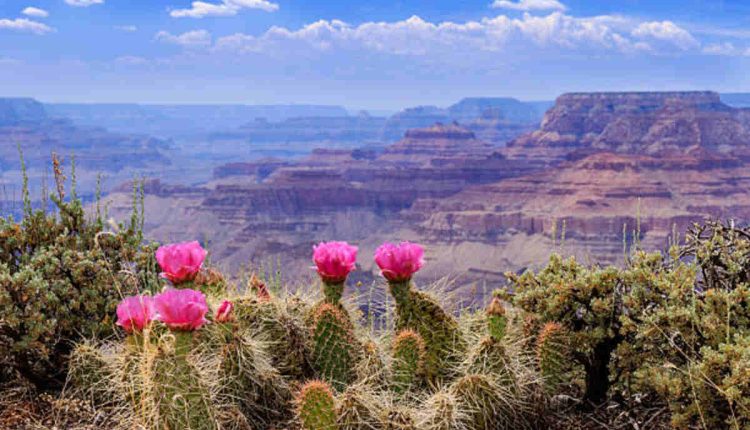Cacti with pink blooms bring rugged desert beauty into any room or office decor and are easy to care for, making excellent houseplants.
The pink-flower hedgehog cactus (Echinocereus fendleri), native to Bandelier National Monument in New Mexico, blooms from April through June with rose pink to magenta-hued flowers.
Prickly Pear Cactus
Prickly pear cacti are native to the desert Southwest and thrive in sandy, well-drained soils with plenty of drainage. Tolerant of drought and heat conditions and animals and insects, their leaves and fruit (nopales) provide humans sustenance, particularly in Mexico and the Southwest. Prickly pear cacti are often seen in gardens in their native region, serving as ornamental borders or specimens; they are ideal candidates for xeriscaping given that they require minimal water requirements as they work well in dry climates and coastal or rock environments.
The Prickly Pear Cactus of Texas is an attractive low-spreading succulent covered by dense spines with thick paddlelike green surfaces and yellow or orange-tinged blooms, producing red fruit with a fleshy interior. Cacti pads can also be stripped of their spines, boiled, and eaten as a vegetable (nopales), and have even been proven to lower cholesterol levels in some studies.
Christmas Cactus
The Christmas Cactus (Schlumbergera) features fleshy, segmented stems topped by brightly-hued flowers in various hues. Often blooming during winter holidays, this houseplant makes a delightful holiday gift! However, this holiday-gift-worthy houseplant may succumb to insects and diseases like other cacti. Gardening Know-How recommends that once flowering has stopped, repotting is necessary.
Christmas cacti require eight weeks of darkness before their flower buds start developing; for optimal results, place them in a dark room or basement for this duration.
Water your Christmas cactus regularly to maintain moist soil if it’s still summertime. Decrease watering when dormant periods arrive, but never allow it to become scorched out. Every four weeks, apply liquid houseplant food such as Plantura Liquid Houseplant Food to boost nutrition when watering the plant.
Hedgehog Cactus
Echinocereus (Ek-in-oh-KER-ee-us) cacti are widely distributed throughout their habitat, yet one stands out in particular: the Chisos Mountains Hedgehog Cactus variety robuster stands out with its combination of distinctive characteristics: knobby stem surface, 10- 17 radial spines in three groups of different sizes and bright magenta flowers.
Plants typically grow in low clumps of single or multiple stems on rocky limestone outcrops in pinyon-juniper woodlands in the southwestern United States at elevations between 4,600 feet and 11,500 feet.
Chisos Mountains hedgehog cacti bloom from April in its southern range to late May in its northern range, producing bright magenta blooms funnel-shaped and with dark green stigma lobes that become funnel-shaped upon blooming. Their spiny fruit matures by July. Unfortunately, this species is endangered; variants have been developed specifically for larger flowers and greater vigor, such as Kingcup Cactus Echinocereus Triglochidiatus or Strawberry Hedgehog Cacti Echinocereus elasticissimus rubrispinus, which have larger flowers and greater power.
Moon Cactus
Gymnocalycium mihanovichii plants boast colorful tops ranging from hot pink and magenta through brilliant orange to almost neon yellow due to a mutation that inhibits photosynthesis (the process by which plants produce plant sugars to fuel their growth). By not producing chlorophyll for photosynthesis, their pigments stand out more vividly – making these cacti ideal gift plants and window box or southern exposure houseplants.
Moon cacti thrive in indoor settings that protect them from direct sunlight and extreme cold. They are sensitive to overwatering; only add liquid when the soil dries.
Due to a lack of chlorophyll, moon cacti cannot survive without being attached to green base plants like Hylocereus species. Debra Lee Baldwin of Succulents Simplified states that grafting the cacti is easy and should only take minutes; according to Baldwin, they typically only last around one year after being attached this way.


Comments are closed.